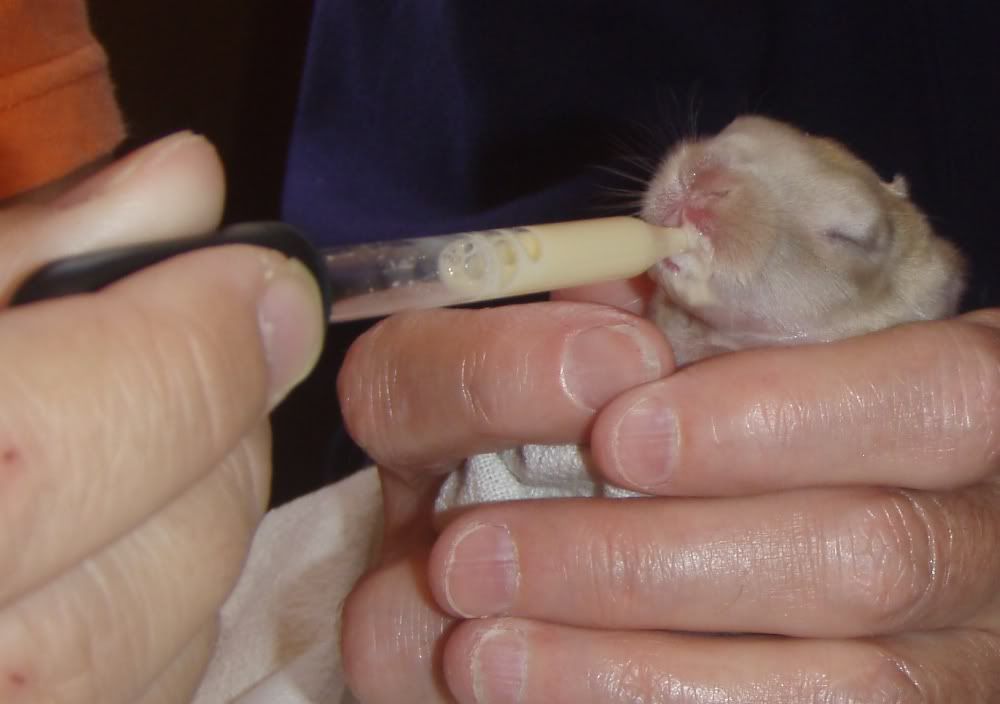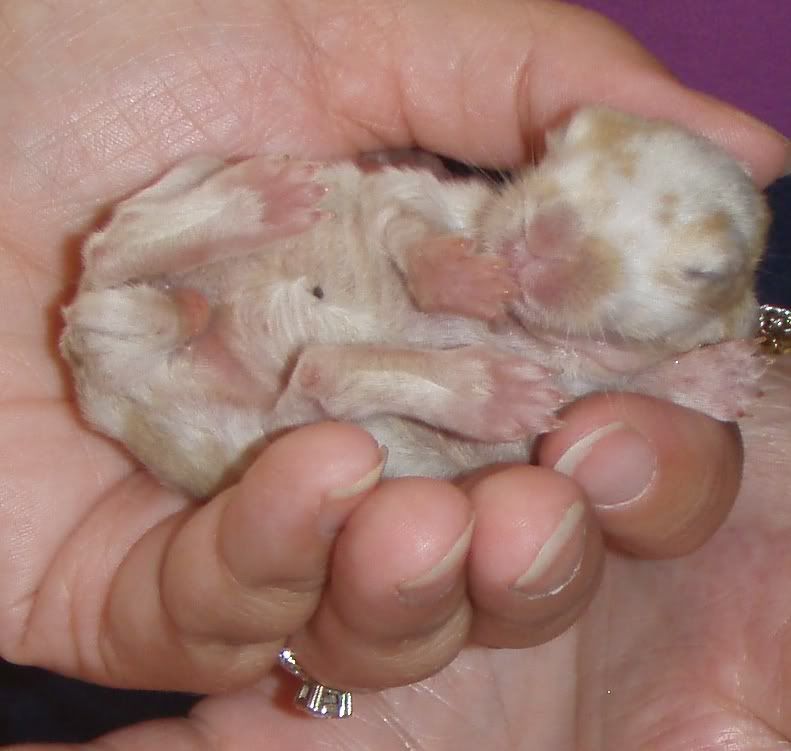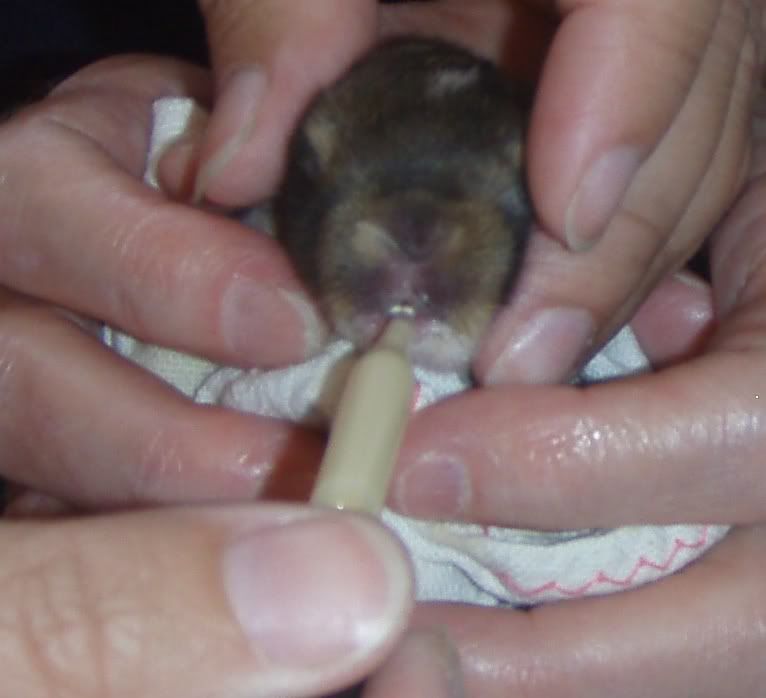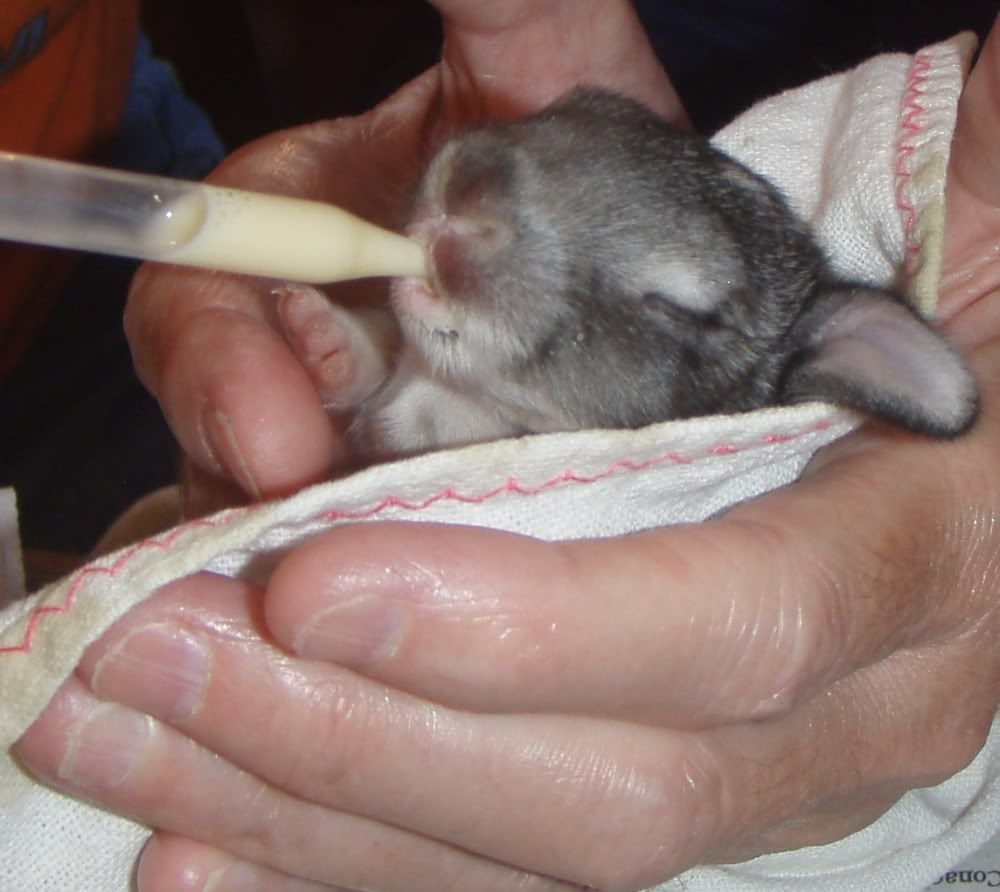- Joined
- Jan 20, 2010
- Messages
- 14,520
- Reaction score
- 32
Well, we've been hand-feeding about half of Squeak's litter. For most of them, we're just supplementing what they're getting from Squeak. Oatmeal coated with blackstrap has been helping Squeak produce more milk, but still not enough to feed the whole litter unaided.
The litter started out with 10, two of them being runts -- a chinchilla and a red. Then one of the others, a broken red, got out of the cage and missed a couple of feedings, effectively making him a runt as well. So when this one, who we called "the prodigal" or "the wanderer" was 4 days old, we started hand-feeding him formula. We added the two runts to this routine, since they were runts. We lost the tiny chinchilla due, I believe, to overfeeding, which I did not know was possible at the time. He died very bloated. We backed off on the others, and the prodigal, who had been looking very similar, started looking more normal.
After a couple more days, we realized that some of the others were falling behind, and that's when I realized Squeak must not be producing enough milk. She's never had this problem before. At the suggestion of others, I checked for mastitis and non-functional nipples. All seemed well, so I started giving her oats coated liberally with blackstrap molasses. I added molasses to a second water bottle, as well, but it started growing algae or something so incredibly quickly in this heat, that I stopped. She's been drinking just fine anyway.
So we ended up hand-feeding five baby buns every night, to supplement what they got in the morning. Sometimes, we would give the four largest a dropper each as well, just for good measure.
We learned that hand-feeding is very time-consuming, because you can give tiny babies only about a half a drop at a time. Then you have to watch their noses, since it is very easy for the milk to get into the nose and make the baby sneeze or have difficulty breathing. We worried that they were aspirating the formula and would end up with pneumonia, but that never happened.
Feeding the prodigal:

Full tummy:

Sometimes we had to hold their heads until they realized that hard thing had food in it:

Feeding the little chinchilla runt:

About a week ago, we realized that the prodigal was probably not getting any food besides formula, so we're now feeding him twice a day. And the red runt, and one of the chestnuts. Of four chestnuts in the litter, only the (slightly) broken did not need supplementation. Two of them have caught up, and no longer need it. The chinchilla that had been one of the big ones has fallen behind just a little, so we've added him in. So now we're feeding four.
They are three and a half weeks old now, and are formula-aholics. Well, except the chinchilla, who isn't really used to the routine yet. So we have to wrap him up like a burrito to feed him. Guess what his name is now...
Here are some videos. As you can see, they are very enthusiastic:
http://s158.photobucket.com/albums/t84/ ... 080034.mp4
I misspoke. I should have said 1/2 Tablespoon, not teaspoon.
http://s158.photobucket.com/albums/t84/ ... 080035.mp4
http://s158.photobucket.com/albums/t84/ ... 080036.mp4
Speaking of names, the prodigal is still, at three and a half weeks, about a third of the size of the largest bunnies in the litter. Unsure whether he will ever reach dinner size, we have named him "Snack". If Snack stays too small, like we think he will, we'll try to find a pet home for him. :roll:
The clues to us that Snack probably wasn't able to get a seat at the dinner table pretty much ever were:
He wasn't really growing.
He was missing some fur.
The fur he did have was scruffy-looking.
His legs were like little toothpicks.
Now he is starting to fill out in his legs a little, and he is getting fur on his tummy and his neck. And he's a little bit bigger.
The formula recipe I'm using:
1/2 Cup canned evaporated goat's milk, undiluted
1/2 Tablespoon corn syrup
1 Egg yolk
It's good for about 4-5 feedings for what I'm doing. The can of milk gives me three batches, I think. I cannot tell you how much the kids love feeding baby bunnies! Okay, it is fun...
Okay, it is fun...
The litter started out with 10, two of them being runts -- a chinchilla and a red. Then one of the others, a broken red, got out of the cage and missed a couple of feedings, effectively making him a runt as well. So when this one, who we called "the prodigal" or "the wanderer" was 4 days old, we started hand-feeding him formula. We added the two runts to this routine, since they were runts. We lost the tiny chinchilla due, I believe, to overfeeding, which I did not know was possible at the time. He died very bloated. We backed off on the others, and the prodigal, who had been looking very similar, started looking more normal.
After a couple more days, we realized that some of the others were falling behind, and that's when I realized Squeak must not be producing enough milk. She's never had this problem before. At the suggestion of others, I checked for mastitis and non-functional nipples. All seemed well, so I started giving her oats coated liberally with blackstrap molasses. I added molasses to a second water bottle, as well, but it started growing algae or something so incredibly quickly in this heat, that I stopped. She's been drinking just fine anyway.
So we ended up hand-feeding five baby buns every night, to supplement what they got in the morning. Sometimes, we would give the four largest a dropper each as well, just for good measure.
We learned that hand-feeding is very time-consuming, because you can give tiny babies only about a half a drop at a time. Then you have to watch their noses, since it is very easy for the milk to get into the nose and make the baby sneeze or have difficulty breathing. We worried that they were aspirating the formula and would end up with pneumonia, but that never happened.
Feeding the prodigal:

Full tummy:

Sometimes we had to hold their heads until they realized that hard thing had food in it:

Feeding the little chinchilla runt:

About a week ago, we realized that the prodigal was probably not getting any food besides formula, so we're now feeding him twice a day. And the red runt, and one of the chestnuts. Of four chestnuts in the litter, only the (slightly) broken did not need supplementation. Two of them have caught up, and no longer need it. The chinchilla that had been one of the big ones has fallen behind just a little, so we've added him in. So now we're feeding four.
They are three and a half weeks old now, and are formula-aholics. Well, except the chinchilla, who isn't really used to the routine yet. So we have to wrap him up like a burrito to feed him. Guess what his name is now...
Here are some videos. As you can see, they are very enthusiastic:
http://s158.photobucket.com/albums/t84/ ... 080034.mp4
I misspoke. I should have said 1/2 Tablespoon, not teaspoon.
http://s158.photobucket.com/albums/t84/ ... 080035.mp4
http://s158.photobucket.com/albums/t84/ ... 080036.mp4
Speaking of names, the prodigal is still, at three and a half weeks, about a third of the size of the largest bunnies in the litter. Unsure whether he will ever reach dinner size, we have named him "Snack". If Snack stays too small, like we think he will, we'll try to find a pet home for him. :roll:
The clues to us that Snack probably wasn't able to get a seat at the dinner table pretty much ever were:
He wasn't really growing.
He was missing some fur.
The fur he did have was scruffy-looking.
His legs were like little toothpicks.
Now he is starting to fill out in his legs a little, and he is getting fur on his tummy and his neck. And he's a little bit bigger.
The formula recipe I'm using:
1/2 Cup canned evaporated goat's milk, undiluted
1/2 Tablespoon corn syrup
1 Egg yolk
It's good for about 4-5 feedings for what I'm doing. The can of milk gives me three batches, I think. I cannot tell you how much the kids love feeding baby bunnies!





















































